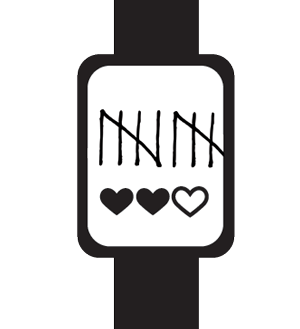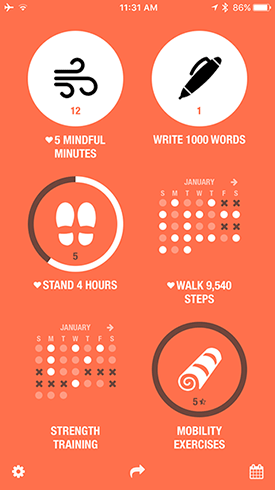![]()
It’s the beginning of February, and we are already one month into a new year. How are things going with those New Year’s Resolutions of yours?
Typically the New Year means an increase in gym attendance, weight loss clubs and dozens of other manifestations of the infamous New Year’s Resolution.
Various folks laugh at the idea of these “silly” attempts at self-improvement and even the rituals themselves. Personally I admire the whole idea of the new year’s resolution since its a vocal and public attempt at self betterment and life improvements. If nothing else, it’s people trying to be better than currently are.
Unfortunately, as winter fades into spring and sometimes much, much sooner, these goals for the new year end up failing. You decide it’s too hard, you are too busy, you aren’t ready or a thousand other justifications for why this year just wasn’t the year to do something you’ve always wanted to. Excuses pile up. Your willpower declines. You give up.
Goals can fail for a lot of reasons, but in my view, one of the main ways we fail in our goals is not setting up a system to track and reinforce new habits and behaviors.
As I wrote in “Achieving Your Goals: Make It Measurable, Trackable and Have a Plan,” there are three steps to increase your chances of successfully reaching your goals: 1. Make It Measurable, 2. Track It, and 3. Have a plan.
By pursuing measurable goals with tracked data, you get on-going feedback. This data shows you your progress objectively. By leveraging a plan that you take from experts and build and modify according to your data and your experience, you take ownership over the process. The cornerstone of this system is getting feedback. And the best way to get feedback is to track.
While there are a lot of ways and tools to track your life, I want to look at few focused examples of how adding a tracking component to your New Year’s Resolution pursuit
Specific Ways To Track Your Goals in 2017
Get a Tracking Device like Apple Watch or FitBit

If your new year’s resolution involves health or fitness, then one of the best ways you can track your goal is with a wearable tracking device. Whether its an activity tracker like a Fitbit, a smart watch like the Apple Watch or a running specific watch from Garmin, typically the first data point you’ll be tracking is your steps.
Counting Steps is arguably the first entry for many into the realm of the quantified self movement. Whether you pursue the mythic, though unscientific, 10,000 steps per day goal or just use it to gauge activity and progress, a step counter or activity tracker is a great choice to make your movement goal measurable and trackable.
Wearable.com has two great posts to help you decide the best smart watch or a fitness tracker for you. Personally I’m currently using the Apple Watch 2, but have good experience with Fitbit devices too.
Activity trackers are no longer limited to just tracking your steps, so you’ll want to look into device that can track your heart rate, sleep or other activities like cycling and swimming.
For example, the Apple Watch lets you track a range of activities like walking, running, swimming and even standing up. It also provides an interesting visualization of your overall activity in color “rings” with the objective of closing all these rings. You can get similar data points from higher end versions from Garmin and Fitbit
Share Your Step Data and Create an Accountabity Group using Gyroscope
Once you’ve started tracking, it’s great to see some of these data points in one places. There are some great aggregators, including Google Fit, Apple Health, and Zenobase, which lets you do the data manipulation and visualization yourself.
One of my favorite apps for aggregating all of my tracking data and even handling my goals is Gyroscope. Gyroscope is a web and iOS app that pulls in data from multiple sources like your computer usage, steps, location, sleep and more to generate a “complete picture” of your life. It is a dashboard or scoreboard for you “tracked” data-driven life. So, if you plan to track you life in one or two ways, I highly recommend Gyroscope to help you see it in one place.
![]()
Once you have joined Gyroscope, started tracking, and have friends on the platform, you can create a group around your steps and fitness. Instead of requiring everyone to use a single device like a fitbit, Gyroscope makes it possible to have a fitness and step tracking group across multiple trackers.
My family members and friends have used leaderboards of steps to encourage us to get moving. By sharing this number, it can push you do beat your friend or family member in who can get the most steps or activity.
Social accountability can be a strong motivator as you pursue whatever goal from being more active, losing weight or running. Having friends and family who are also improving can increase your success rate too.
Measure and Track Your Goals with Streaks app on iOS

Ultimately most new year’s resolution aims at either creating a positive habit or removing a negative one. Habits and routines are the core of who we are, and by embracing a process of self-improvement we are often striving to do and maintain life-long positive habits.
One of the best books on habits (and a book I’ve gifted and recommended many times) is “The Power of Habit” by Charles Duhigg. In the book, Duhigg uses research and personal experience to show how much of our lives and organizations are driven by habit loops which he defines as “simple cue-routine-reward loops.”
If you are looking for a good summary in audio format, checkout Tony Robbin’s Podcast on “The #1 Secrete to Productivity,” where Duhigg provides a great overview of the book and its core tenets as well as some of its most famous examples.
Fortunately, habits can also be tracked. I’m a big believer in habit tracking. There are a dozens of habit trackers. Personally I’ve tried and use a myriad of tools to track my habits.
Currently I track my morning routine use Productive, which is an indie iOS app to log your habits each day. I track my main personal goals like mindfulness hours and walking using Steaks, which allows for 6 goals and integrates with Apple Health to automatically log if you complete them.
Streaks is a great app that brings a a lot of focus to your habit building and tracking. By pulling data from Apple Health, it is able to know if you actually did your meditation time or walk enough steps for that day.
Some other habit tracking tools I like are HabitBull, Way of Life, and AskMeEvery. Most are free or only a few dollars so you can try a few to find what works best for you.
In general, I recommend starting with just one or two goals and build from there. If you attempt to track and build too many habits at once, you risk getting overwhelmed. Start small like sleeping 7 hours per night or daily stretching. Once you’ve completed these consistently, it’s fun to start augmenting and building your routine.
And, if you are looking for an initial positive habit to try and add to your life, I recommend Flossing Everyday. It’s simple and stupid one but can build a serious life style change. It’s good for you health and creates this aura of getting things done in a consistent way for your betterment.
Track Your Habits and Go on Quests with a “Gang” using Habitica
![]()
Streaks and many other apps and sites are great tools if you just want to track yourself. These self-trackers are good starting point for tracking habits, but what about other people? Is there a social gamification platform for habits? That’s where Habitica comes in.
Habitica is a Habit Tracker App where you track your goals while also participating in a role playing game. It’s main strength is the social component. By completing tasks and habits, you earn points to equip and upgrade your avatar. Its original name was HabitRPG.
Similarly, you are able to join a questing party to defeat monsters. This is where things get interesting since your success and failure in completing your habits can either help or hurt your party. Forget to do your habits? Your party takes some damage too. Go on a streak of awesome habit completion? You contribute to helping kill the evil villains and collect rewards.
So, if you are looking to create a general positive change around your habits, the social pressure and gamification on Habitica just might help. It’s fun and can be mildly addictive too. It’s open source and has tons of funny little additions to keep you engaged while ultimately improving your behaviors and habits.
![]()
Conclusion: Why You Should Track Your Goals
I think New Year’s Resolutions are great. For at least once a year you can declare a specific area you want to improve and optimize for the year to comee. We as a culture have even made it an acceptable and encouraged thing to do. We form clubs and help each other make it happen. Unfortunately the major of these goals end up failing.
One of the reasons I think is you don’t track them and subsequently build the habit of consistency and accountability.
Whether your new years resolution is a simple one or a complicated multi-step pursuit, consistency is key. You need to make regular and consistent progress. Goals fail all the time and that’s ok. But if you want to increase your chance at success, you need to turn goals into habits and systems of behaviors.
Early on a good way to create a system for your pursuit and new year’s resolution is to track your behavior. In this post, we looked at a few ways you can track goals using a wearable device to track your health, Gyroscope to aggregate your data, Streaks to record your habits, and Habitica to pursuit habits with friends and colleagues.
As a pretty obsessive self-tracker, I’ll admit that I might be over tracking my life. For now this is largely experimental as I try out different approaches, log new areas and discover the most meaningful ways to track and grow.
Beyond the main examples I’ve provided in this post, there are a lot of areas you can track depending on the goal you are pursuing. If your goal is about making sure you put in enough time (or avoid too much time on something negative), then I recommend tracking your time using tools like RescueTime and Toggl. If you are worried about mobile phone addiction, start tracking your phone usage with an app like Moment. If you are trying to read more, you can track your book reading using GoodReads. If you aren’t getting enough sleep, then I recommend tracking your sleep in order to know how much sleep you are getting and how more sleep might improve your productivity and mood.
If you are looking for more ideas on tracking and goals, check out my post “How to Track a Life: Ultimate Guide of Tools, Apps and Techniques for Self-Tracking” where I go more depth on self-tracking.
I’ll admit that new year’s resolution can be hard. I fail at a few each and every year. Fortunately I succeed at a few others too each year. So overall things are moving in a positive direction. Don’t fret if you fail from time to time. That’s part of the process.
Hopefully by adding tracking to your new year’s goals, you can improve your chance at success.
Good luck and happy tracking!
